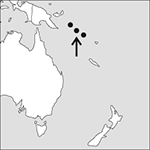
Source: MAPS IN MINUTES™ © RH Publications (1997)
Capital:
Honiara
Area:
28,896 sq km (11,157 sq miles)
Population:
597,248 (2013 est)
Currency:
1 Solomon Islands dollar = 100 cents
Religions:
Protestant 73.4%; Roman Catholic 19.6%; other Christian 2.9%
Ethnic Groups:
Melanesian 95.3%; Polynesian 3.1%; Micronesian 1.2%
Languages:
English (official); Melanesian pidgin; minority languages
International Organizations:
UN; Commonwealth; South Pacific Forum; Secretariat of the Pacific Community; WTO
An island country in the south-west Pacific.
Physical
The Solomon Islands form a large archipelago comprising a double chain of six large and many smaller islands, lying between 5° and 13° S of the Equator. The largest island, Bougainville, together with a few others in the north-west, is part of Papua New Guinea; all the rest constitute a country in which the most important island is Guadalcanal. Lying at the edge of the Pacific plate, the region is subject to earthquakes; and there are volcanoes on the main islands.
Economy
The economy collapsed during the ethnic violence of 1998–2003, but slowly recovered after order was restored. Agriculture employs three-quarters of the workforce, the principal crops being cocoa, coconuts, palm kernels, and rice; tuna fishing, tuna canning, and timber are also important. Timber, fish, copra, palm oil, and cocoa are exported. The Solomon islands have extensive undeveloped mineral resources, such as lead, zinc, nickel, and gold. The one gold mine closed in 2014. The country has one of the lowest per capita GNPs in the world.
History
After some 3000 years of occupation, European missionaries and settlers arrived throughout the 18th and 19th centuries, and in 1885 the German New Guinea Company established control of the north Solomons. Britain declared a protectorate over the southern islands in 1893. During World War II the Solomons witnessed fierce battles between Japanese and Allied forces. The Solomon Islands became an independent member of the Commonwealth of Nations on 7 July 1978. Solomon Mamaloni (Prime Minister since 1989) faced severe criticism during 1991 for allegedly ignoring the constitution and seeking to rule without a mandate. Following an election in 1993, the independent Francis Billy Hilly became Prime Minister. His short-lived administration ended in late 1994, when Mamaloni again won power. Relations with Papua New Guinea continued to be strained. After elections in 1997 a new government was formed, with Batholomew Ulufa’alu as Prime Minister. Ethnic violence broke out on Guadalcanal in 1998 between the indigenous population and the Malaitan community (from the neighbouring island of Malaita). This escalated until 2003, when an Australian-led peacekeeping force was deployed. Peace was thereafter gradually restored, but in 2006 there were anti-government disturbances and also tensions between the government and the peacekeeping force. The latter were resolved, and in 2014 the peacekeeping force became a policing force, ahead of its withdrawal in mid 2017. In 2009 a Truth and Reconciliation Commission was established to look into the violence of 1998–2003, when over 100 died and 20,000 were displaced.
- upthrust
- uptime
- Upton Warren
- UPVC
- up vector
- upward compatibility
- upward continuation
- upward lightning
- upwelling
- Ur
- uracil
- Uralian orogeny
- uralite
- uralitization
- Ural Sea
- uranian satellites
- uraninite
- uranium
- uranium deposit
- uranium enrichment
- uranium hexafluoride
- uranium(IV) oxide
- uranium-lead dating
- meso form
- mesoglea